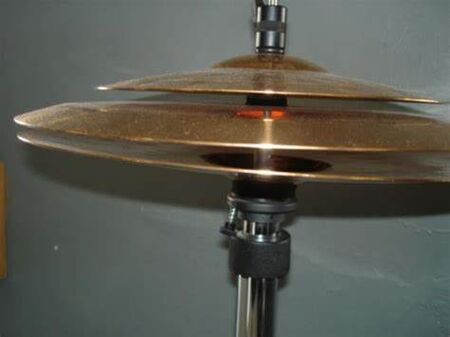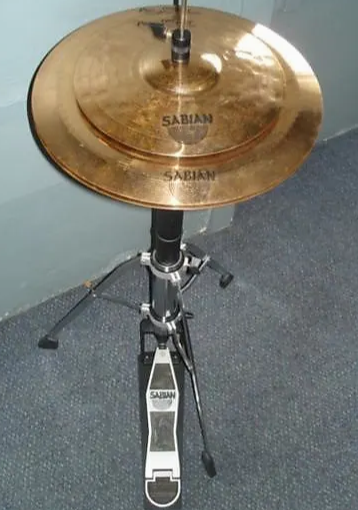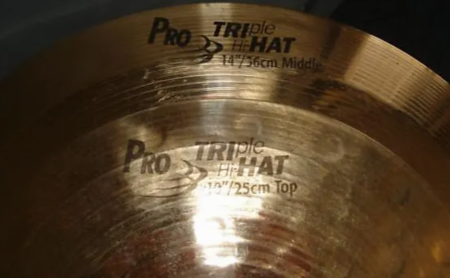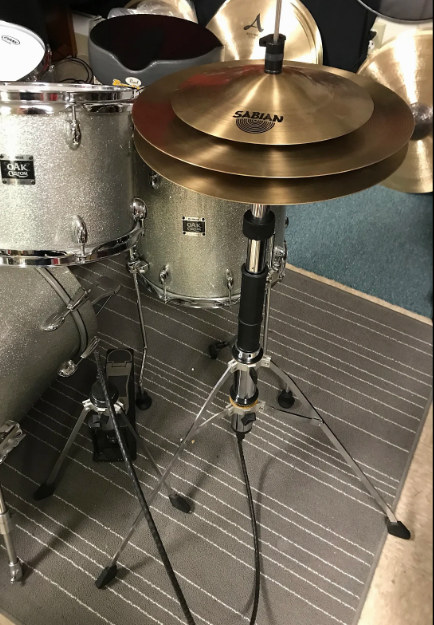Sabian AA Triple Hi-Hats
This model was comprised of a 10" "Top" cymbal over a pair of 14" hi-hats. Sabian designed special stands for this model. (both pictured)
Group: Hi-Hats
Type: Triple Hats
Size: 10 / 14 / 14 Inch
Series: AA
Weight: Top (10"): ?g / Top (14"): ?g / Bottom: ?g
Years of production: 1999 or 2000 - ?
Sound file: AA Triple Hats
AA Triple Hats (with explanation in Spanish)
Sabian's Description: <<< - >>>
Review: "On a standard hi-hat, depressing the pedal draws the top cymbal down to meet the stationary bottom cymbal. Simple. On Sabian's Triple Hi-Hat, the middle cymbal remains stationary. Depressing the pedal draws the top cymbal down to meet it. Simultaneously, the bottom cymbal rises to meet the middle cymbal. In simple terms this explains how the stand works. But the next question must be "Why would I want three hi-hat cymbals?" In a word: more. More sound targets. More sound combinations. And, depending on how you play them, more sound—period.
Triple Hi-Hat cymbal sets include a standard 14" bottom cymbal, a 14" middle cymbal with no bell, and a 10" top cymbal. The sets are available in a choice of Sabian's AA or PRO series cymbals. Both types sound bright and focused, but the PROs have a more pronounced high end.
Your first step on the Triple Hi-Hat's pedal will go a long way toward explaining why three might be a magic number. The chick sound is powerful. The additional cymbal contributes another frequency component. Surprisingly, this broader-spectrum sound is no less defined than a standard two-cymbal hi-hat. If you play in situations where the chick sound gets lost, or you need it to really cut through the roar of the band, this setup will help deliver you to the promised land of audibility.
And if you're looking for more horsepower when riding on the hi-hat, the Triple provides it in spades. Just angle your stick so that it strikes both the top and middle cymbal. That extra frequency component (a term that sounds far too polite in this context) gives you "bash" by the boatload.
The flat middle cymbal has a reverse-flanged edge for optimal contact with the bottom cymbal. Being quite thick, its pitch is high—even higher than that of the bottom cymbal. The 10" top cymbal has a large, deep bell designed to accommodate the top of the middle rod. This and its medium weight make it sound much more gongy than a splash when it's played alone. But it does provide a dramatic sonic contrast when "crashed." That contrast is also useful when you play ride patterns with the tip of the stick between the top and middle cymbals, especially while they're open.
By moving the 10" cymbal higher on the rod (beyond where it will contact the middle cymbal with the pedal action), you can play between it and the middle cymbal. This facilitates playing "double-time" patterns and single-handed rolls by striking the underside of the top cymbal with upstrokes. The pitch relationship of these cymbals makes this a fun and interesting effect.
Of course, there may be times when you want a more modest hi-hat sound—like for those low-volume gigs at the Elks lodge. Sabian gives you the option of converting the Triple Hi-Hat into a (somewhat) conventional "double." Just remove the middle cymbal, screw down the middle rod so that it doesn't obstruct the top cymbal's motion, and replace the 10" top cymbal with a standard top cymbal. In this configuration, the action is comparable.
If you don't have to have a "matching" top cymbal, you can use any 14" hi-hat top cymbal. (I tried this, and it worked just fine.) Otherwise, Sabian offers matching 14" top cymbals at additional cost.
The innovative transport mechanism in the middle of the Triple Hi-Hat stand requires exceptionally large tubing. Otherwise, the Triple looks much like a regular hi-hat stand. Aspring-loaded thumb-screw can be tightened to tilt the bottom cymbal. The clutch looks fairly standard, although instead of nuts to secure the top cymbal from below, it has a "clutch bolt" with an integrated platform for the washer and cymbal to rest on. The bolt (male) threads into the clutch (female). This design might offer a little more secure connection, since there is more area of threaded contact between the parts. Rubber rings are used in most areas where you'd normally find felt washers. Several manufacturers have adopted this change, because the rubber rings are thought to have less of a muffling effect on the sound. The pedal features a standard chain-drive linkage.
The stand has single-braced legs, but it seems stable enough even for "lead-foot" players. Three hook-and-loop material strips on the bottom of the base plate keep it in place on a carpet or rug. The entire tripod rotates to make room for other pedals and stand bases. The simple footboard features non-slip rubber in the middle, heel, and toe sections. There is no toe stop.
Spacing the cymbals evenly for "standard" triple play is easy: First loosen the clutch's wing bolt. Then depress the pedal until the bottom and middle cymbals touch. (This lowers the pull rod to the same degree.) Then retighten the clutch.
The opposing motion of the cymbals has two interesting effects. Compared with a regular hi-hat, the Triple's pedal stroke is only half as long as the distance between the two cymbals. Therefore, even at a comfortable stroke length, the cymbals can be quite far apart. Also, the action of the two cymbals moving toward each other amplifies the force with which they strike. Both of these factors contribute to a louder chick sound with the same effort, even when you use just two cymbals.
Changing the height of the Triple Hi-Hat's lower and middle cymbals is pretty cumbersome, and considerably more involved than on a conventional hi-hat. But to cut Sabian some slack, this may be unavoidable when dealing with the interaction of three objects whose heights are all interdependent. Also, most players only adjust the stand's height once, and then leave it alone.
The three-position tension adjustment, located just above the stand's tripod, is quick and easy to use. But even at the lightest setting, the pedal action is stiffer than that of most conventional hi-hats. You can feel the inertia of the additional machinery, as well as the gravity that pushes one cymbal up while pulling the other one down. Even so, this stiffness doesn't inhibit fast playing; it just feels less "floaty" than standard light-action pedals. Sabian claims that the Triple Hi-Hat actually facilitates faster playing because the top and bottom cymbals move toward each other. Theoretically, I would agree. But I'm more inclined to say that this double action merely offsets the mechanism's inherent resistance.
You can't say Sabian doesn't take chances. They create radical cymbal lines like Radia and V-FX, and now they're offering a new take on a very familiar part of the kit. The Triple Hi-Hat feels different, but not so different that you couldn't get used to it in a few days. It opens up unprecedented tonal variation possibilities, and facilitates stronger and more cutting hi-hat sounds than you may have ever imagined. If you want to bring your hi-hat out of the shadows and into the spotlight, the Triple deserves a serious look. (Sabian also offers remote cable models of the Triple Hi-Hat, with or without cymbals, with a choice of a short [5'] or a long [8'] cable.)"
Review written by Rich Watson ("New And Notable - Sabian Triple Hi-Hat", Modern Drummer, October 2000, pp.48-9)
Artist/song where it can be heard:




